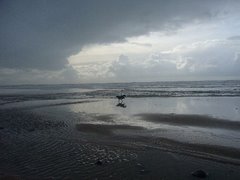
Newfoundlands are valuable members of beach rescue services in Italy and in France. The dogs are trained to jump out of helicopters and boats and swim to the rescue of struggling swimmers. They are credited with having saved several lives by taking lifebuoys to swimmers and towing them to safety. A strong relationship with the handler is fundamental, especially in the water. It takes three years to train a dog completely. The training is rigorous and only top dogs graduate but it's their natural qualities that serve them best. The flaps of skin between their toes make them strong swimmers, and their thick layers of fat insulate them from cold waters. The dogs get very excited when they see someone in the water — and that's a good thing. It means they react quickly and without hesitation when someone is in need of rescue. The four-legged lifeguards are always teamed up with human partners, but it's the dogs who do most of the work. They often pull several people in at once — even boats — to safety. These rescue dogs are heirs to a centuries-old tradition across Europe, where they've long been loyal companions to fishermen.
In previous posts I referred to two rescues which went down in history:
1. Napoleon is rescued from rough seas in his attempt to escape from Elba
2. the Newfoundland who saved lives after the Titanic went down














